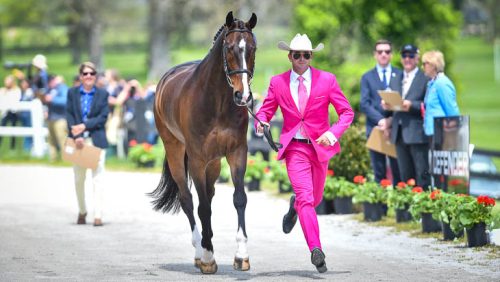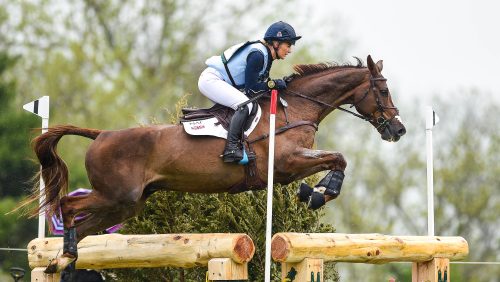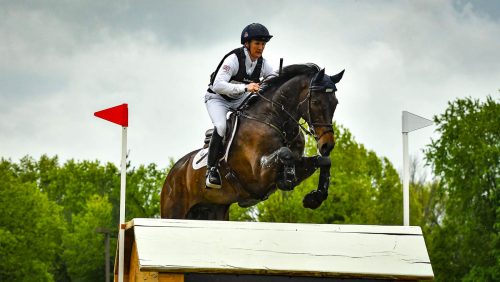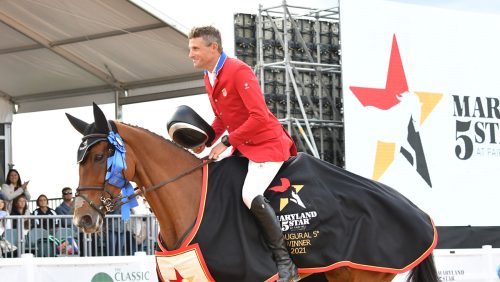Nov. 20—Leesburg, Va.
Whether it was a green horse just starting its career or a seasoned four-star mount, six-time Olympian Mary King’s approach to flatwork never wavered. Developing a strong competitor is dependent on the basics.
In her clinic put on by Kelly Gage of Team EnGaged on Nov. 20 at Morven Park in Leesburg, Va., King implemented exercises that benefited the greener mounts but could be tweaked to challenge the more experienced ones. While the exercises looked simple, appearances proved to be deceptive.
She didn’t send the riders home with quick fixes, but strategies and assignments for making the horse more responsive and developing rider effectiveness.
King started the day by explaining that she liked to give her horses a 10- to 15-minute walk prior to a schooling session and said she often schooled out in a field because most English events take place on grass.
She likes to begin her training sessions working in a longer and lower frame to encourage horses to stretch down to get them working forward over their backs.
“If you consistently work them like that when you first start to work them, they get used to it, and it can help them to relax,” King said.
If a horse was feeling a bit fresh, she didn’t want the rider to take back, but she encouraged them to include canter work earlier in the session to help dispel the silliness.
“If they’re being a little bit jolly at the start, that’s fine. Let them get rid of their energy,” she said. “When [I finish my warm-up] I pick them up and then they’ve got to behave themselves and be nice and good.”
Think About Yourself
While the riders were doing their warm-up, King encouraged them to take some time to think about their position. She suggested that they run through a mental checklist about where their body should be—a skill she stressed was important to remember outside of lessons where it’s easy to fall into bad habits.
“The more effective you sit, the more effective you’ll be,” she reminded. “To be effective you want to have a nice straight upper body, nice and vertical as you’re working your horse on the flat. The more vertical you are, the more you can sit down on your bottom—sit deep into the saddle as you’re going on to canter or sitting trot.”
ADVERTISEMENT
She encouraged the riders to find professionals whom they admired and work to emulate them.
“Have a picture of them in your mind and try and copy how they ride,” she said. “I’ve progressed a lot by doing that.
“So on the flat it would be Carl Hester for me,” she continued. “I would trot around at home while I’m schooling my horse, and I’ll pretend that I was Carl Hester. I’ll picture him in my mind—how beautiful and tall and straight he sits, how nice and still his hands are, his lower leg position.
“Each phase I’ll have somebody. For the show jumping for me there’s Ben Maher who’s also in our country. I think it’s fantastic the way he sits—how soft he is, how he is with his horses.
“And then cross-country riding in the olden days it would be Lucinda Green who was my heroine! I would copy her at the time. I even went to the hairdressers with a picture of her and asked the hairdressers to cut my hair like hers! She was such a heroine of mine, but I love the way she rides with her lower leg so forward, so secure, letting her horses gallop on.”
Bread And Butter Work
Regardless of the mount’s skill level, King insisted every ride should include the “bread and butter work”—a few minutes checking their transitions. For younger horses, she wanted them to perform transitions while maintaining an outline. For the preliminary-and-above riders, she started asking them for more—including transitions within the gaits and transitions through the halt.
King stressed that obtaining a good halt required a forward motion into the movement, taking back beforehand only encouraged them to lean on the reins. When Helen Hayn’s mount started sinking back after the halt, King wanted her to react immediately and make him step forward instead.
She challenged the riders to remain strict—especially those with developing horses that wanted to lose their shape through the transitions.
When Audra Spouse’s Irish Sport Horse Calando lifted his head as she asked for his canter transition, King insisted that she hold onto the trot and wait until he was producing a rounder gait before proceeding to the canter.
“Especially at the lower levels, if you can ride very correct, true transitions at the markers you’re three-quarters of the way to obtaining a very good dressage score,” King said.
Poles Develop Adjustability
ADVERTISEMENT
King only built one pole exercise: four poles set on a circle at 12 o’clock, 3, 6 and 9 without measuring for striding. Riders began cantering over the poles set at 12 and 6 to develop a rhythm before adding the last two poles to the equation.
Once they were cantering comfortably around the circle, King had the riders count the strides aloud in between to gauge how well they could feel their horse’s gait.
Horses further along in their education were asked to demonstrate a change in stride between sections, often alternating between four and five strides to challenge the riders to remain adjustable at all times.
When Jane Jennings’ gelding kept cross cantering after hitting the poles out of stride, King reminded her not to get frustrated—his discontinuity was a good thing because he’d force her to be more precise in her striding.
Tidbits And Takeaways
– King suggested that riders using overreach boots should cut about an inch off of the bottom because they’re often too long, resulting in tripping on course if the horse put his full weight on the back of the boot.
– King cautioned against using a breastplate to keep the saddle in place. While she uses a breastplate with a running martingale on her horses, she always runs with it fairly loose.
“They’re using their shoulders a lot more, and if they’ve got a tightness there it’s just something that is restrictive. Something that is a tiny bit distracting for them to have something that’s maybe a little uncomfortable. You want them to be as comfortable and as free as possible in the tack they’re wearing so they don’t get slightly distracted in what they are doing.”
– “You get all sorts [of horses] and it’s fascinating,” King said. “It’s very easy as a rider to think that that’s the perfect event horse, but you go to Badminton Horse Trials and watch the vet inspection, I think you call it the jog over here, and it’s fascinating seeing about 80 horses at Badminton and all sorts of horses get there.
“Their shape [differs]—some tall ones, some shorter ones, some fatter ones, some thinner ones—but at the end of the day they all want to do it. They’ve got that grit and determination as characters in them to want to gallop and jump around these great big courses, so who’s to say what is the perfect event horse?”
– “They shouldn’t be like a bicycle that you keep pedaling forward,” she said. “They should stay trotting and cantering on in front of your leg.
“A little bit of pressure, if there’s no reaction, a little slap of the heels so that they then learn that they must just move forward just from a little bit of pressure.”
– “One thing [Carl Hester] told me that has stuck in my mind is to make the front of your body longer,” she said. “It just pulls you up, it makes you very tall, you’re immediately then in a very correct position.”














